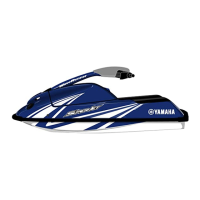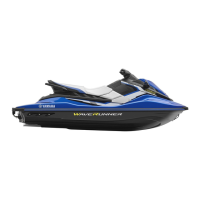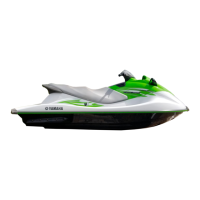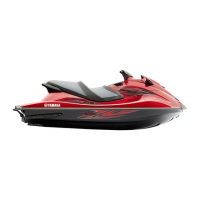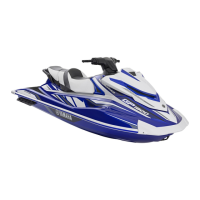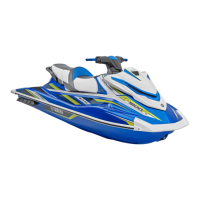
Do you have a question about the Yamaha 2011 WaveRunner FZR and is the answer not in the manual?
| Bore x Stroke | 86 mm x 78 mm |
|---|---|
| Starting System | Electric |
| Lubrication System | Wet Sump |
| Engine Type | 4-stroke, 4-cylinder |
| Displacement | 1812cc |
| Fuel Capacity | 70 L |
| Length | 3.48 m |
| Width | 1.27 m |
| Dry Weight | 365 kg |
| Fuel Type | Unleaded gasoline |
| Fuel Delivery System | Electronic Fuel Injection |
| Cooling System | Water-cooled |
| Length (m) | 3.48 |
| Width (m) | 1.27 |
| Fuel Capacity (L) | 70 L |
| Hull Type | Modified V |
Introduction and guidance for using the manual and obtaining maximum enjoyment.
Explains the meaning and use of the safety alert symbol to warn of potential injury hazards.
Defines a WARNING as a hazardous situation that could result in death or serious injury.
Defines a NOTICE as special precautions to avoid damage to the watercraft or other property.
Defines a TIP as key information to make procedures easier or clearer.
Explains how to record Primary Identification (PRI-ID), Hull Identification Number (HIN), and engine serial number.
States engine conformity to U.S. EPA and California Air Resources Board (CARB) regulations.
Location of the manufactured date label on the cylinder head.
Explains California Air Resources Board (CARB) star labels for emission standards.
Instructions to read various labels before using the watercraft.
Lists and explains various warning labels on the watercraft for safety.
Shows and identifies other labels on the watercraft.
Recommends minimum operator age, supervises minors, and specifies maximum load capacity.
Advises on safe operation, visibility, speed, and avoiding hazards like submerged objects.
Details required safety gear like PFDs, protective clothing, eye protection, footwear, and helmets.
Lists essential safety equipment to carry on board, such as signaling devices and towlines.
Warns about the dangers of exhaust fumes (carbon monoxide) and hot engine surfaces.
Explains jet thrust, steering response, reverse operation, and intake grate safety.
Outlines waterway navigation rules, right-of-way, and buoyage systems.
Provides resources for additional boating safety information and training courses.
Emphasizes responsible operation, respecting others, nature, and proper maintenance.
Defines key terms related to watercraft operation, such as trolling, planing, bow, and stern.
Identifies and labels external components of the watercraft.
Overview of various controls and their operations.
Explains the function, handling, and care of the remote control transmitter.
Details the security system for preventing unauthorized use or theft.
How to set and confirm security system modes using the remote transmitter.
Instructions on how to operate the engine stop switch to halt the engine.
Explains the function of the engine shut-off switch and lanyard for safety.
Instructions on how to start the engine using the start switch.
How the throttle lever controls engine speed and returns to idle.
How turning the handlebars controls the watercraft's direction.
Instructions on how to adjust the handlebar position for comfort.
Location and function of cooling water pilot outlets for system checks.
Function of the water separator and procedures for draining collected water.
Overview of key operational functions of the watercraft.
How to use the reverse system safely and effectively, including warnings.
Adjusting the trim angle of the jet thrust nozzle for optimal performance.
Overview of different operating modes available on the watercraft.
Function, activation, and deactivation of the Low RPM Mode.
Description of the main instrument display and its initial operation.
How the speedometer indicates watercraft speed in km/h and MPH.
How the tachometer indicates engine speed in RPM.
Details on the information display showing operating conditions.
Functionality of the hour meter and voltmeter for tracking usage and battery voltage.
Indicates the amount of fuel remaining in the tank using display segments.
Warning indication for low fuel levels, including visual and audible alerts.
Warning for low oil pressure, indicating potential engine damage.
Warning for engine overheating, requiring immediate action to prevent damage.
Warning for sensor malfunctions or short circuits, requiring dealer inspection.
Instructions on how to remove and install the front and rear seats.
Description of the reboarding grip used for boarding the watercraft from the water.
How to use the reboarding step to assist in boarding the watercraft from the water.
Use of the bow eye for attaching ropes during transport, mooring, or towing.
Use of stern eyes for attaching ropes during transport or mooring.
Information on various storage compartments and their water-resistant properties.
How to open, close, and drain the bow storage compartment.
How to open, close, and drain the glove compartment.
Location and use of the removable beverage holder within the glove compartment.
How to open, close, and remove the watertight storage compartment.
How to use the fire extinguisher holder and cover located in the bow storage compartment.
Recommended fuel type (regular unleaded gasoline) and minimum octane rating.
Safety precautions for handling and refueling gasoline to prevent fire and injury.
Recommended engine oil type (SAE) and grade (API).
Safety precautions and procedures for checking the engine oil level.
Procedures for draining bilge water from the engine compartment.
Procedure for draining bilge water when the watercraft is on land.
Procedure for draining bilge water while the watercraft is on water.
Instructions for safely securing the watercraft to a trailer.
Procedure for breaking in the new engine for optimal performance and longevity.
A comprehensive checklist for pre-launch and post-launch checks.
Detailed checks to perform before operating the watercraft.
Ensuring the engine compartment is properly ventilated and free of damage.
Checking the fuel system for leaks, damage, and proper component condition.
Checking the water separator for collected water and draining if necessary.
How to check the engine oil level and ensure it is within the specified range.
Checking battery terminals, leads, breather hose, and electrolyte level.
Checking the steering system for smooth operation and proper free play.
Ensuring smooth operation and secure locking of the telescopic steering system.
Checking the Quick Shift Trim System (Q.S.T.S.) operation and selector lock.
Checking the smooth operation of the reverse system and gate movement.
Checking throttle lever operation, return function, and free play.
Ensuring the remote control transmitter operates properly.
Checking the condition of the engine shut-off cord (lanyard) for damage.
Checking the proper operation of start, engine stop, and shut-off switches.
Checking storage compartments for damage and water accumulation.
Checking the fire extinguisher holder, cover, band, and ensuring a full extinguisher is present.
Ensuring required safety equipment meeting regulations is on board.
Checking the hull and deck for damage or other problems.
Checking the jet intake for damage or clogging with weeds or debris.
Checking stern drain plugs for damage and proper thread condition.
Ensuring the hood is securely closed before operation.
Performing checks after launching the watercraft into the water.
Checking for water discharge from the cooling water pilot outlets.
Verifying the proper operation of the dual analog meter unit.
Checking the engine idling speed against the specified range.
Introduction to operating the watercraft and becoming familiar with controls.
Learning basic techniques through practice over time.
Performing pre-operation checks, understanding laws, and operating defensively.
Correct operator and passenger riding positions for stability and control.
Procedures for safely launching the watercraft.
Step-by-step instructions to start the engine safely while on the water.
How to stop the engine safely, with warnings about steering.
Procedures for preventing accidental starting or unauthorized use when leaving.
How the watercraft moves forward based on shift lever and throttle.
Techniques for turning, emphasizing throttle use for steering control.
How the watercraft stops using water resistance, with stopping distances.
How to operate the watercraft in reverse safely.
Procedures and warnings for boarding the watercraft from the water.
Step-by-step guide for boarding the watercraft by yourself.
Guidance for boarding with a passenger, emphasizing balance and safety.
How to board the watercraft when it is stationary.
Boarding techniques for maintaining balance, especially with a passenger.
Safe procedures for starting off after boarding, avoiding collisions.
How to start off after launching the watercraft from a trailer.
Procedures for boarding and starting off when using a dock.
Procedures for safely uprighting a capsized watercraft.
Steps for safely beaching and docking the watercraft.
Advice for operating in areas with weed growth and cleaning the jet intake.
Post-operation procedures for discharging water from cooling passages.
General care procedures after operating the watercraft, including cleaning.
Procedure to flush cooling passages to prevent clogging with salt or dirt.
Steps for cleaning the watercraft, including rinsing and drying.
How to care for the battery, including removal, storage, and terminal cleaning.
Procedures for storing the watercraft for extended periods, like winter.
Steps for cleaning the watercraft, including flushing passages and waxing.
Lubricating moving parts like cables and rods for smooth operation.
Applying rust inhibitor to metallic parts of the hull, deck, and engine.
Importance of periodic checks and lubrication for safe and efficient operation.
Contents and proper storage of the included tool kit.
Step-by-step instructions for removing and installing the engine cover.
Schedule for regular maintenance tasks, indicating items checked by owner and dealer.
Procedures for changing engine oil and oil filter, with safety warnings.
Guide to diagnosing and resolving common problems with the watercraft.
Chart listing troubles, possible causes, remedies, and page references.
Procedures for handling emergencies like clogged jet intakes or impellers.
How to clean the jet intake and impeller to remove weeds or debris.
How to start the watercraft battery using a 12-volt booster battery and jumper cables.
How to safely replace blown fuses, including location and amperage.
How to replace the bilge pump fuse with the correct amperage spare.
Procedures for safely towing an inoperative watercraft.
Procedures if the watercraft becomes submerged or flooded.
Details of the watercraft's limited warranty, including coverage and exclusions.
Information about the optional extended service plan for continued protection.
